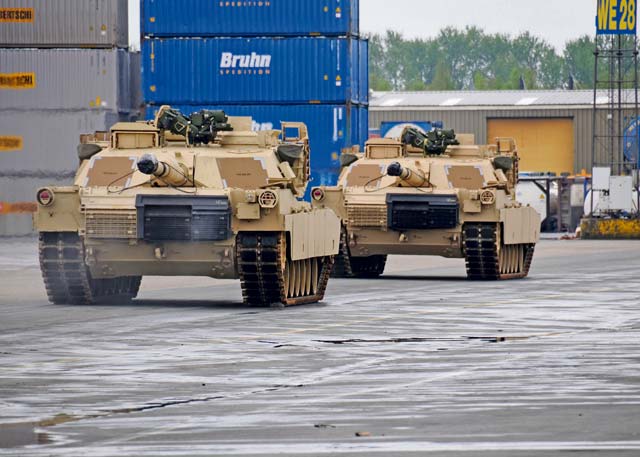
Two M1 Abrams tanks move down the docks of Antwerp toward their holding area after being offloaded from the freighter “Resolve,” April 24.
Members of the 16th Sustainment Brigade and 21st Theater Sustainment Command, along with other U.S. and Belgian agencies, coordinated and offloaded additional European Activity Set vehicles and equipment April 24 at the port of Antwerp, Belgium.
Included in the shipment were multiple M1 Abrams tanks, M2 Bradley Infantry Fighting Vehicles and numerous other equipment that will help rotational forces complete their training and mission requirements during their time in Europe.
Completing movements, such as the one in Antwerp, requires the coordination of multiple agencies such as the 21st TSC, 16th Sust. Bde., Belgian army, Belgian port directors, Surface Deployment and Distribution Command, and private contracting.
“There’s a lot of coordination involved in this movement,” said Maj. Brandon Wilkins, the 21st TSC’s Support Operations, Transportation Integration Branch Sea officer in charge. “If you can keep that synchronization going, it all comes together.”
The movement to Antwerp and onward to its final destination at Coleman Barracks, has not been without its challenges.
“This has been different because it’s the first time we’ve used Antwerp for a mission like this,” Wilkins said. “We were a little unfamiliar at first, and there had been a lot of last minute preparation to make this happen.
“It’s all come together though,” he continued. “The equipment has arrived, and it’ll move on to its next destination soon.”
For the Soldiers involved, the operation was a great opportunity to test their skills doing a job that not many in the military get to experience.
“I love port operations and especially being a part of the whole planning process,” said 1st Lt. Deniece Tukaufu, a mobility officer with the 16th Sust. Bde. “It’s not just about receiving the equipment and making sure the serial numbers are correct, but also scheduling the onward movement of the equipment.”
Tukaufu’s team, along with the Belgian army, is also responsible for providing security and eyes on the equipment held at the port until it can be loaded onto a barge and moved forward.
According to U.S. Army Europe, the prepositioning of vehicles and equipment in Europe will allow the Army to save time, money and resources by rotating personnel into theater rather than shipping large equipment back and forth across the ocean. It also allows the Army to be more flexible and responsive in meeting the needs of combatant commanders in the region.


